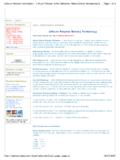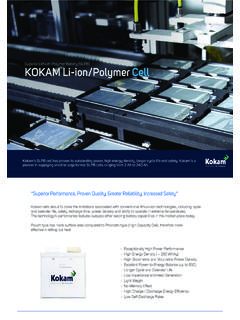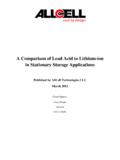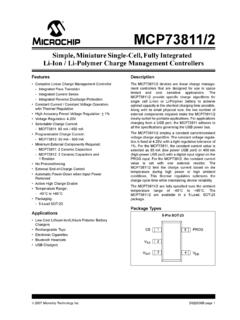Transcription of Modeling the Performance and Cost of Lithium …
1 Modeling the Performance and cost of Lithium -Ion Batteries for Electric-Drive VehiclesANL-12/55 SECOND EDITIONC hemical Sciences and Engineering DivisionAvailability of This ReportThis report is available, at no cost , at It is also available on paper to the Department of Energy and its contractors, for a processing fee, from: Department of Energy Office of Scientific and Technical Information Box 62 Oak Ridge, TN 37831-0062 phone (865) 576-8401 fax (865) 576-5728 report was prepared as an account of work sponsored by an agency of the United States Government. Neither the United States Government nor any agency thereof, nor UChicago Argonne, LLC, nor any of their employees or officers, makes any warranty, express or implied, or assumes any legal liability or responsibility for the accuracy, completeness, or usefulness of any information, apparatus, product, or process disclosed, or represents that its use would not infringe privately owned rights.
2 Reference herein to any specific commercial product, process, or service by trade name, trademark, manufacturer, or otherwise, does not necessarily constitute or imply its endorsement, recommendation, or favoring by the United States Government or any agency thereof. The views and opinions of document authors expressed herein do not necessarily state or reflect those of the United States Government or any agency thereof, Argonne National Laboratory, or UChicago Argonne, LLC. About Argonne National Laboratory Argonne is a Department of Energy laboratory managed by UChicago Argonne, LLC under contract DE-AC02-06CH11357. The Laboratory s main facility is outside Chicago, at 9700 South Cass Avenue, Argonne, Illinois 60439. For information about Argonne and its pioneering science and technology programs, see Modeling the Performance and cost of Lithium -Ion Batteries for Electric-Drive VehiclesANL-12/55 SECOND Nelson, Gallagher, I.
3 Bloom, and DeesElectrochemical Energy Storage ThemeChemical Sciences and Engineering Division Argonne National LaboratoryDecember 2012 ii This Page Intentionally Left Blank iii TABLE OF CONTENTS LIST OF FIGURES .. viii LIST OF TABLES .. xi ABBREVIATIONS .. xii LIST OF SYMBOLS .. xiv ACKNOWLEDGEMENTS .. xviii PREFACE TO THE SECOND EDITION .. xix EXECUTIVE SUMMARY ..xx 1. Introduction ..1 2. Battery and Cell Design Format ..3 Cell Module Design ..7 Modules Using Liquid Thermal Management ..7 Modules Using Air Thermal Management ..7 Battery Pack Design ..8 Batteries Using Liquid Thermal Management ..8 Batteries Using Air Thermal Management ..10 3. Modeling of Battery Design and Performance ..13 Criteria for Power, Energy, and Life.
4 13 Voltage at Rated Power ..15 Governing Equations ..21 Calculation of the ASI ..22 Current Collection Resistance ..24 iv Potential and Current Distribution ..26 Determination of Module Terminal Size ..28 Calculation of Battery Dimensions ..29 Cell Dimensions ..29 Module Dimensions ..30 Battery Pack Dimensions ..30 Maximum Electrode Thickness ..30 4. Thermal Management ..37 Heat Generation Rates in the Battery Pack during Driving ..37 Heating under Adiabatic Conditions ..43 Active Thermal Management Systems ..43 Thermal Management with Ethylene-Glycol/Water Solution ..44 Thermal Management with Cabin Air ..50 Cooling and Heating Required to Maintain Pack Temperature ..51 Heat-up from Cold Ambient Conditions.
5 52 5. Modeling of Battery Pack Manufacturing cost ..53 Approach ..53 Materials Costs and Purchased Items ..54 Battery Specific Materials cost ..54 Purchased Items cost ..59 Pack Integration cost ..59 Baseline Manufacturing Plant ..62 Receiving and Shipping ..63 v Electrode Materials Preparation ..65 Electrode Coating ..65 Calendering ..66 Inter-Process Materials Handling ..66 Electrode Slitting ..67 Final Electrode Drying ..67 Control Laboratory ..67 Cell Stacking ..68 Current Collector Welding ..68 Enclosing Cell in Container ..68 Electrolyte Filling and Cell Sealing ..69 Dry Room Management ..69 Formation Cycling, Final Cell Sealing, etc ..69 Module and Battery Assembly.
6 70 Rejected Cell and Scrap Recycle ..71 Baseline Plant Summary ..72 Adjustment of Costs for Rates ..72 Plant Investment Costs ..75 Unit Costs for Battery Pack ..75 Variable Costs ..75 Fixed Expenses ..76 Profits ..77 Battery Pack Warranty Costs ..77 vi Summary of Baseline Battery cost ..77 Uncertainties in Price Estimates ..80 Materials and Capital Electrode Thickness ..80 Cell Capacity ..81 Example of Contribution to Calculated Uncertainty ..81 Breakdown of Costs ..82 6. Description of Spreadsheet Model and Instructions for Use ..87 Background ..87 Instructions ..87 Enabling Calculation ..87 Chem Worksheet ..87 Battery Design Worksheet ..87 Remaining Worksheets.
7 92 Battery Design Format Requirements ..95 Troubleshooting and General Advice ..95 Suggested Number of Cells, Modules, and Performance Inputs ..96 Entering a New Material Couple ..96 Entering Parallel Cell, Module, or Pack Configurations ..98 7. Illustrated Results ..99 Number of Cells in Series ..99 Cathode Materials ..100 Parallel-Connected Cell Groups and Electrode Thickness ..100 vii Manufacturing Scale ..102 8. Statement of Copyright ..105 References ..106 Appendix A: BatPaC Variation Study ..111 viii LIST OF FIGURES Cell sandwich inside of prismatic pouch cells ..4 Coated current collector foil for prismatic electrodes ..5 Prismatic cell in stiff pouch container with aluminum conduction channel added for heat rejection from a liquid cooled module.
8 6 Provision for cooling cells with cabin air ..6 Module with hermetically sealed aluminum container for batteries utilizing a liquid thermal management approach ..7 Module using air heat transfer fluid with polymer container open at top and bottom ..8 Insulated battery jacket with enclosed modules that are exposed on their upper and lower surfaces to an ethylene glycol-water heat transfer fluid ..9 Battery pack utilizing air thermal management approach..10 Summary flow of the design model ..14 a) Required change in [V/U] to maintain rated power with increases in internal resistance over the life of the battery. b) Increase in current due to lowered [V/U] ..17 Change in heat rejection requirement from increases in resistance for batteries with different designed voltages at rated power.
9 18 Efficiencies for batteries designed to achieve rated power at different fractions of their open-circuit voltage ..20 The change in current and potential within the positive and negative foils. The current collection design results in a uniform current distribution along the length of the foil ..27 Cell capacity simulated at the C/1 and C/3 rate as a function of electrode thickness (loading) for NCA-Gr..33 Normalized electrolyte salt concentration at the end of discharge at the C/1 and C/3 discharge rates..33 Calculated ASI from a simulated 10-s, 5C discharge pulse for the NCA-Gr cell couple at 60% SOC..34 The potential of the negative electrode versus a hypothetical Lithium reference electrode located in the center of separator during a 5C charge pulse for the NCA-Gr couple.
10 35 ix Plot comparing the estimated resistance to heat transfer from the cell center to the cooled surface of the module to that calculated by the FlexPDE model ..46 Heat transfer from the module wall to the laminar flow heat transfer fluid. The temperature profile of the fluid is shown at different lengths down the path..47 Temperature profile in the heat transfer fluid for various fractions of the dimensionless path length..49 Correlation of model simulation results relating the Graetz number and mean Nusselt number for laminar flow between an insulated surface and the module casing ..49 Metal ingot cost contribution to the current collector foils over a 20 year period ..58 Baseline Lithium -ion battery manufacturing plant schematic diagram ..63 Breakdown of installed capital equipment costs for the baseline plant.







